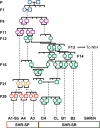Genetics of hypertension: an assessment of progress in the spontaneously hypertensive rat
- PMID: 28916635
- PMCID: PMC5792135
- DOI: 10.1152/physiolgenomics.00065.2017
Genetics of hypertension: an assessment of progress in the spontaneously hypertensive rat
Abstract
The application of gene mapping methods to uncover the genetic basis of hypertension in the inbred spontaneously hypertensive rat (SHR) began over 25 yr ago. This animal provides a useful model of genetic high blood pressure, and some of its features are described. In particular, it appears to be a polygenic model of disease, and polygenes participate in human hypertension genetic risk. The SHR hypertension alleles were fixed rapidly by selective breeding in just a few generations and so are presumably common genetic variants present in the outbred Wistar strain from which SHR was created. This review provides a background to the origins and genesis of this rat line. It considers its usefulness as a model organism for a common cardiovascular disease. The progress and obstacles facing mapping are considered in depth, as are the emergence and application of other genome-wide genetic discovery approaches that have been applied to investigate this model. Candidate genes, their identification, and the evidence to support their potential role in blood pressure elevation are considered. The review assesses the progress that has arisen from this work has been limited. Consideration is given to some of the factors that have impeded progress, and prospects for advancing understanding of the genetic basis of hypertension in this model are discussed.
Keywords: SHR; blood pressure; genetics; mapping; review.
Copyright © 2017 the American Physiological Society.
Figures


Similar articles
-
Combined genealogical, mapping, and expression approaches to identify spontaneously hypertensive rat hypertension candidate genes.Hypertension. 2005 Apr;45(4):698-704. doi: 10.1161/01.HYP.0000156498.78896.37. Epub 2005 Feb 14. Hypertension. 2005. PMID: 15710778
-
Genetic isolation of a region of chromosome 8 that exerts major effects on blood pressure and cardiac mass in the spontaneously hypertensive rat.J Clin Invest. 1997 Feb 15;99(4):577-81. doi: 10.1172/JCI119198. J Clin Invest. 1997. PMID: 9045857 Free PMC article.
-
Alleles of the spontaneously hypertensive rat decrease blood pressure at loci on chromosomes 4 and 13.Biochem Biophys Res Commun. 1997 Sep 18;238(2):586-9. doi: 10.1006/bbrc.1997.7342. Biochem Biophys Res Commun. 1997. PMID: 9299556
-
Genetics in arterial hypertension--clinical and experimental aspects.Herz. 1995 Oct;20(5):309-14. Herz. 1995. PMID: 7498877 Review.
-
Genealogy of the spontaneously hypertensive rat and Wistar-Kyoto rat strains: implications for studies of inherited hypertension.J Cardiovasc Pharmacol. 1990;16 Suppl 7:S1-5. J Cardiovasc Pharmacol. 1990. PMID: 1708002 Review.
Cited by
-
2022 updates to the Rat Genome Database: a Findable, Accessible, Interoperable, and Reusable (FAIR) resource.Genetics. 2023 May 4;224(1):iyad042. doi: 10.1093/genetics/iyad042. Genetics. 2023. PMID: 36930729 Free PMC article.
-
Acetyltransferase p300 Is a Putative Epidrug Target for Amelioration of Cellular Aging-Related Cardiovascular Disease.Cells. 2021 Oct 22;10(11):2839. doi: 10.3390/cells10112839. Cells. 2021. PMID: 34831061 Free PMC article. Review.
-
Epoxyeicosatrienoic Acid Analog and 20-HETE Antagonist Combination Prevent Hypertension Development in Spontaneously Hypertensive Rats.Front Pharmacol. 2022 Jan 17;12:798642. doi: 10.3389/fphar.2021.798642. eCollection 2021. Front Pharmacol. 2022. PMID: 35111064 Free PMC article.
-
Thick Ascending Limb Sodium Transport in the Pathogenesis of Hypertension.Physiol Rev. 2019 Jan 1;99(1):235-309. doi: 10.1152/physrev.00055.2017. Physiol Rev. 2019. PMID: 30354966 Free PMC article. Review.
-
Chronic Administration of Red Yeast Rice Mitigates Endothelial Dysfunction in Spontaneously Hypertensive Rats by Inhibiting Oxidative Stress and Endothelial Nitric Oxide Synthase Uncoupling.Curr Vasc Pharmacol. 2024;22(5):355-364. doi: 10.2174/0115701611295900240529104225. Curr Vasc Pharmacol. 2024. PMID: 38847159
References
-
- Aitman TJ, Glazier AM, Wallace CA, Cooper LD, Norsworthy PJ, Wahid FN, Al-Majali KM, Trembling PM, Mann CJ, Shoulders CC, Graf D, St Lezin E, Kurtz TW, Kren V, Pravenec M, Ibrahimi A, Abumrad NA, Stanton LW, Scott J. Identification of Cd36 (Fat) as an insulin-resistance gene causing defective fatty acid and glucose metabolism in hypertensive rats. Nat Genet 21: 76–83, 1999. doi:10.1038/5013. - DOI - PubMed
-
- Atanur SS, Birol I, Guryev V, Hirst M, Hummel O, Morrissey C, Behmoaras J, Fernandez-Suarez XM, Johnson MD, McLaren WM, Patone G, Petretto E, Plessy C, Rockland KS, Rockland C, Saar K, Zhao Y, Carninci P, Flicek P, Kurtz T, Cuppen E, Pravenec M, Hubner N, Jones SJ, Birney E, Aitman TJ. The genome sequence of the spontaneously hypertensive rat: Analysis and functional significance. Genome Res 20: 791–803, 2010. doi:10.1101/gr.103499.109. - DOI - PMC - PubMed
-
- Atanur SS, Diaz AG, Maratou K, Sarkis A, Rotival M, Game L, Tschannen MR, Kaisaki PJ, Otto GW, Ma MC, Keane TM, Hummel O, Saar K, Chen W, Guryev V, Gopalakrishnan K, Garrett MR, Joe B, Citterio L, Bianchi G, McBride M, Dominiczak A, Adams DJ, Serikawa T, Flicek P, Cuppen E, Hubner N, Petretto E, Gauguier D, Kwitek A, Jacob H, Aitman TJ. Genome sequencing reveals loci under artificial selection that underlie disease phenotypes in the laboratory rat. Cell 154: 691–703, 2013. doi:10.1016/j.cell.2013.06.040. - DOI - PMC - PubMed
-
- Bell R, Herring SM, Gokul N, Monita M, Grove ML, Boerwinkle E, Doris PA. High-resolution identity by descent mapping uncovers the genetic basis for blood pressure differences between spontaneously hypertensive rat lines. Circ Cardiovasc Genet 4: 223–231, 2011. doi:10.1161/CIRCGENETICS.110.958934. - DOI - PMC - PubMed
Publication types
MeSH terms
Grants and funding
LinkOut - more resources
Full Text Sources
Other Literature Sources
Medical

